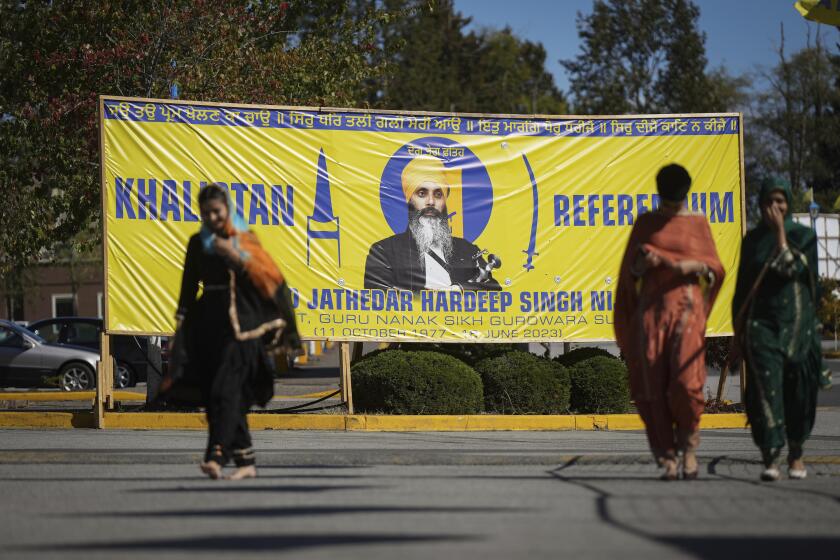Bethlehem Is Praying That Tourists Return
Bethlehem knows what it wants for Christmas: tourists.
All over Manger Square and the rest of town, shopkeepers, hotel owners and just plain folks are hoping that visitors come and stay -- if only for a night.
Pilgrims are the primary source of income in Jesus Christ’s traditional birthplace, and town leaders, while mourning Palestinian leader Yasser Arafat, are encouraged by a lull in Israeli-Palestinian fighting since his death last month.
“We hope things will get better and pray every day for tourists to come back,” said Nidal Dar El-Qurneh, a guide at the Church of the Nativity. “It’s been so hard recently, especially the last four years of the intifada.”
The intifada, or Palestinian uprising, has devastated tourism throughout the Holy Land, and occasionally the violence spilled into Bethlehem.
Israeli forces entered the town of 40,000 in the spring of 2002 in a West Bank-wide sweep after a string of bloody suicide bombings. The soldiers encircled the Church of the Nativity after Palestinian gunmen fled inside, mounting a five-week siege that left bullet holes in the 4th century shrine. Among those killed was a Palestinian bell ringer, hit by a stray bullet as he walked to work.
At formerly bustling Manger Square, just outside the church, the town’s troubles are evident.
Some of the bullet holes in the church are still visible, and the turquoise blue doors of the stores lining the streets are bolted. Those that are open -- to sell baby Jesus figures in all sizes and glow-in-the-dark statues of the Virgin Mary -- say they’re lucky to get a few customers a week.
Christmas celebrations here once attracted tens of thousands of tourists -- but that was before the violence.
Bethlehem Mayor Hanna Nasser said 120,000 tourists once visited every month. Now the number is about 10,000.
And on Christmas Eve and Christmas Day, when tens of thousands of people would normally pour in, Nasser doubts that even 1,500 will come to attend services.
That’s a shame, say visitors like Heather Baker of Denver, Colo., who was visiting the Church of the Nativity with fellow students from Jerusalem International University College.
The 31-year-old graduate student and her friends dismissed the notion that the West Bank town is unsafe, and suggested that TV news gave a false impression. In Bethlehem, she said, they felt welcome.
“My dad is also coming to visit” for Christmas, she said. “He’s excited.”
In a sign of renewed cooperation, the Israeli and Palestinian tourism ministers announced an agreement to ease travel restrictions and promised all visitors that the Holy Land was safe.
The Vatican’s representative in Israel was among those who signed a proclamation promoting pilgrimage to the Holy Land.
Meanwhile, Father Amjad Sabbara, a priest in Bethlehem, urged Christians to come in solidarity and help those who work in the tourism industry to earn their “daily bread through dignity.”
Unfortunately, it won’t look a lot like Christmas, Nasser said. “Because of the death of Yasser Arafat, there are no Christmas decorations. We are still in a mourning period.”
In the last four years of fighting, the town has put up few decorations, or none, to reflect the grim situation.
At the Orient Palace Hotel, which is next to Manger Square, visitors can book a single for $22 a night, including breakfast. Even at that rate, though, the best that hotel worker Amin Abu Kamel hopes for is to rent all 25 rooms to visiting journalists.
“I would like to see people,” he said. “And peace.”
Hotel owners and shopkeepers swept up and stocked fresh merchandise, and at the Arab Women’s Union craft center, two women pulled out needlework napkins festooned with candle designs in festive red and green.
In a workshop where artisans crafted religious figures, Adel Darawe, 39, wrapped his sawdust-covered fingers around a figure of Jesus Christ and used a drill to carve a lamb draped over its shoulders.
A devout Muslim in the 35% Christian town, he has been crafting Jesus figures for 34 years.
But he hasn’t had much work lately, carving two days a week rather than six. But he’s staking his hopes on Christmas to help him feed his family of 11.
“I hope the situation will calm down and everyone will come back,” he said after etching another line in Jesus’ face. “They are most welcome.”
More to Read
Start your day right
Sign up for Essential California for news, features and recommendations from the L.A. Times and beyond in your inbox six days a week.
You may occasionally receive promotional content from the Los Angeles Times.






